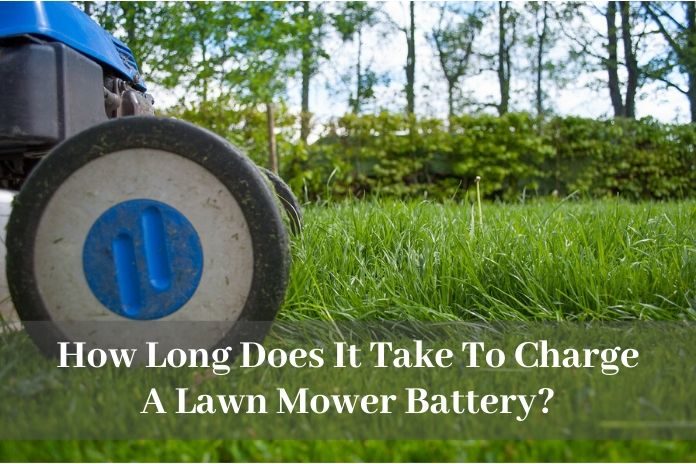
Like it’s with the cars, you are likely to fall victim to a flat lawn mower battery. Often, the mower batteries do run out of charge, especially when the mower is left idle for a long time. One amazing thing is that you don’t have to worry about a flat battery. With the right charger, you can get the lawn back on the road quickly.
How long does it take to charge a lawnmower battery? With the perfect battery charger, it should take at least four to six hours to fill the battery in your lawnmower.
How Does the Lawnmower Battery Work?
Before you even start on the process to recharge your lawn mower battery, it’s advisable that you first understand how the battery in the mower works. One thing to note is that it operates the same way as it’s in a car. In simpler terms, the energy it preserves is consumed via the alternator charging unit. It’s for this reason that the battery asks for a continuous charging, after every use.
7 Steps You Should Follow When Charging Your Lawn Mower Battery?
Now that you are aware of how the battery in your mower operates, your next move is to proceed with the charging process. So, how can you charge the battery? First, there are some precautions that you ought to follow. When it comes to charging, it would be best if you considered using a well-ventilated area. Most garages and carports may not work well on these instances as the batteries tend to release harmful gases during the process.
Often, professionals may insist that you jumpstart the lawnmower using your car battery. Well, the trick does work wonders. However, if not careful, this can cause more damages to your lawnmower battery. It can cause an explosion or even toxic vapors.
Also, when connecting the charger, you must ensure that you don’t touch the terminals using bare hands. Besides, you should be careful not to bridge the terminals with any conductor as this can trigger damages onto your battery, as well as, the tractor itself.
1. Choose the Right Charger
The first step towards ensuring an effective charging process is picking the right charger for the job. The selection is based on the voltage of the battery in question. Most lawn mowers run on a 12-volt battery, which matches their electrical system. However, there are some customized lawn tractors, and which operate on a six-volt battery.
Thankfully, today, most chargers can handle a range of voltages. You only need to switch between the various ranges to pick a voltage that matches the battery in your lawnmower.
Should You Use a Fast-Charging Mode, Timed Charging or the Trickle Mode?
These are among the many options that today’s chargers are likely to give. From an expert’s perspective, the 2-amp rate is the most recommended for your lawn tractor. By using this charge rate, you allow a deep and thorough charge.
2. Check What the Manufacturer Has to Say Before Connecting the Charger
Every lawn mower is designed differently. Manufacturers usually impose a set of instructions that you should follow to improve the motor’s lifespan. It would best if you first read and understood the mower’s specifications. The vehicle’s manual can provide you with specific instructions that are there for your make and model.
3. Prepare the Battery for Charging
With the right charger and instructions ringing at the back of your head, you are ready to start the charging process. You can choose to charge the battery while it’s in its housing to remove it outside. Whatever option you pick, it won’t affect the battery’s ability to charge.
However, from an expert’s perspective, you should withdraw the battery from the housing and charge it while it’s outside.
4. Connect the Charger to the Battery
Now that you are ready to charge, you should start by attaching your charger to the battery, and that’s before you stick the charger to a wall socket. Remember to start with the positive terminals, then followed by the negative ones.
The cables shouldn’t be hard to identify as they come colored as red for the positive terminal and black for the negative one. Ensure that the charger cables are tightly held to the battery terminals before you proceed to the next step.
5. Stick the Charger to a Wall Socket
Once you are sure that the charger cables are held in position, you should connect the charger to the power supply. However, before you do that, it would be best if you remembered to set the charge rate first. However, you can still monitor the charging as most chargers usually have a light to warn you when the charging is complete.
But, it doesn’t make sense to monitor the charging now that the process takes about four to six hours to fill the battery. Timing the charging saves you from the stress that comes from the fear of the battery getting overcharged.
6. Switch Off the Charger When the Charging Is Complete
After four to six-hour of charging, your lawn mower battery should be filled to the brim. The charger should warn you when the work is done. One amazing thing about the smart chargers is that automatically shut off the flow of charge once the battery attached is full.
Therefore, if you receive the warning, you should go ahead and turn off the switch in your charger. After switching off the charger, continue to unplug the charger from the power outlet on the wall. If your charger has no switch, you can go ahead and unplug it directly from the power supply.
7. Allow Some Time for the Battery to Rest Before Disconnecting the Charger
During the charging process, gases may accumulate around the battery. The gas may mean harm to your battery, if not allowed to disperse. It’s recommended that you let the battery rest for at least five minutes before detaching the charger cables.
When you are sure that gas is gone, you can then proceed to remove the negative charger cable from the battery followed by the positive cable. With the charger out of your way, you can return the battery in its housing and connect its positive terminal first then followed by the negative one.
Conclusion
Charging your lawn mower battery shouldn’t be difficult as most people make it sound. By following the guidelines provided in this article, you should have your battery full in the next five hours or so. After that, you should be able to resume using your lawn tractor.
There are instances when the battery may fail to hold a charge. If you encounter this, it means that your battery is too old or there is a parasitic electrical drain in the system.
Sources:
1. Why Does the Battery Keep Dying on My Riding Mower? – Home Guides | SF Gate





